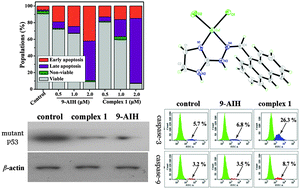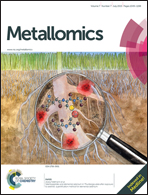Synthesis and antitumor mechanisms of a copper(ii) complex of anthracene-9-imidazoline hydrazone (9-AIH)†
Abstract
A new anthracycline derivative, anthracene-9-imidazoline hydrazone (9-AIH), was synthesized and selected as an antitumor ligand to afford a copper(II) complex of 9-AIH, cis-[CuIICl2(9-AIH)] (1). Complex 1 was structurally characterized by IR, elemental analysis, ESI-MS and single crystal X-ray diffraction analysis. By MTT assay, it was revealed that 1 showed overall a higher in vitro cytotoxicity than 9-AIH towards a panel of human tumour cell lines, with IC50 values from 0.94–3.68 μM, in which the BEL-7404 cell line was the most sensitive to 1. By spectral analyses and gel electrophoresis, the DNA binding affinity of 9-AIH and 1 was determined. 9-AIH was suggested to bind with DNA in an intercalative mode, with a quenching constant of 1.04 × 104 M−1 on the EB–DNA complex. While for 1, both intercalative and covalent binding modes were suggested. By flow cytometry, 1 was found to block the cell cycle of BEL-7404 cells in a dose-dependent mode, in which it induced the G2/M phase arrest at 0.5 μM and induced the S phase arrest at higher concentrations of 1.0 or 2.0 μM. From the cellular morphological observations under different fluorescence probe staining, a dose-dependent manner of 1 to induce cell apoptosis in the late stage was suggested. Comparatively, equivalent apoptotic cells, respectively, in the early and late stages were found when incubated with 2.0 μM of 9-AIH. The mitochondrial membrane potential measured by JC-1 staining and the ROS generation in cells detected using a DCFH-DA probe suggested that the cell apoptosis induced by 1 might undergo the ROS-related mitochondrial pathway. Accordingly, the mutant p53 expression was found to be suppressed and the caspase cascade (caspase-9/3) was consequently activated by 1. This action mechanism for 1 in the BEL-7404 cells was unique and was not found in the presence of 9-AIH under the same conditions, indicating their different antitumor mechanism. Furthermore, the in vivo acute toxicity of 1 tested on mice indicated that 1 should be a high cytotoxic antitumor agent, with the LD50 value in the range of 32–45 mg kg−1, which is much higher than that of 9-AIH. From the above results, the central Cu(II) of 1 in the coordinated mode with 9-AIH was believed to play a key role in exerting both the high cytotoxicity and the effective antitumor mechanism.



 Please wait while we load your content...
Please wait while we load your content...